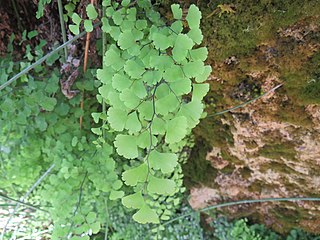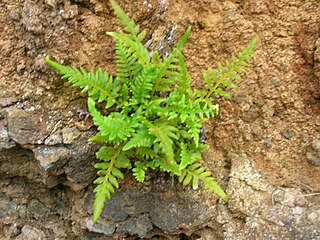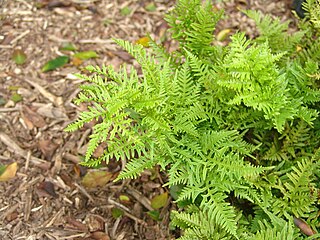
Adiantum, the maidenhair fern, is a genus of about 250 species of ferns in the subfamily Vittarioideae of the family Pteridaceae, though some researchers place it in its own family, Adiantaceae. The genus name comes from Greek, meaning "unwetted", referring to the fronds' ability to shed water without becoming wet.

Adiantum capillus-veneris, the Southern maidenhair fern, black maidenhair fern, maidenhair fern, and venus hair fern, is a species of ferns in the genus Adiantum and the family Pteridaceae with a subcosmopolitan worldwide distribution. It is cultivated as a popular garden fern and houseplant.

Pteridaceae is a family of ferns in the order Polypodiales, including some 1150 known species in ca 45 genera, divided over five subfamilies. The family includes four groups of genera that are sometimes recognized as separate families: the adiantoid, cheilanthoid, pteridoid, and hemionitidoid ferns. Relationships among these groups remain unclear, and although some recent genetic analyses of the Pteridales suggest that neither the family Pteridaceae nor the major groups within it are all monophyletic, as yet these analyses are insufficiently comprehensive and robust to provide good support for a revision of the order at the family level.

Adiantum bellum is a species of fern in the family Pteridaceae, and is native to Bermuda.
Adiantum fengianum is a species of maidenhair fern endemic to China. Its natural habitat is temperate forests. It is threatened by habitat loss.

Adiantum lianxianense is a species of maidenhair fern native to China. While the IUCN Red List describes it as extinct, due to habitat loss, it may still survive, as it has frequently been confused with other members of the genus.

Anogramma ascensionis, the Ascension Island parsley fern, is a species of fern in the family Pteridaceae that is endemic to Ascension Island, a volcanic island in the South Atlantic Ocean. It is one of eight putative species in the genus Anogramma. It was thought to have become extinct due to habitat loss, until four plants were found on the island in 2010. Over 60 specimens were then successfully cultivated at Royal Botanic Gardens, Kew and on Ascension Island. It is now classified as Critically Endangered.
Hecistopteris pinnatifida is a fern species in the Vittarioideae subfamily of the Pteridaceae. It is endemic to Ecuador. Its natural habitat is subtropical or tropical moist lowland forests. It is threatened by habitat loss.

Pteris adscensionis is a fern species in the subfamily Pteridoideae of the family Pteridaceae. It is endemic to Ascension Island, and there are thought to be fewer than 500 individuals left in the wild. Its natural habitat has been severely reduced due to the large number of species introduced to the island when it was first settled in the 18th century.
Aleuritopteris albofusca is a species of fern in the family Pteridaceae. It is endemic to China, including Tibet. Its natural habitat is subtropical or tropical dry forests. It is threatened by habitat loss.
Aleuritopteris grevilleoides is a species of fern in the family Pteridaceae. It is endemic to China. Its natural habitat is subtropical or tropical moist lowland forests. It is threatened by habitat loss.
Vittaria longipes is a fern species in the subfamily Vittarioideae of the family Pteridaceae. It is endemic to Ecuador. Its natural habitat is subtropical or tropical moist lowland forests. It is threatened by habitat loss.

Adiantum jordanii is a perennial species of maidenhair fern, in the Vittarioideae subfamily of the Pteridaceae. The species is known by the common name California maidenhair.
Adiantum gertrudis is a threatened species of ferns in the Vittarioideae subfamily of the Pteridaceae that occurs in central South America. One locus of occurrence of A. gertrudis is within central Chile at the La Campana National Park. A morphological trait unique to A. gertrudis is the hairs covering its fronds.

Adiantum pedatum, the northern maidenhair fern or five-fingered fern, is a species of fern in the family Pteridaceae, native to moist forests in eastern North America. Like other ferns in the genus, the name maidenhair refers to the slender, shining black stipes.

Adiantum viridimontanum, commonly known as Green Mountain maidenhair fern, is a rare fern found only in outcrops of serpentine rock in New England and Eastern Canada. The leaf blade is cut into finger-like segments, themselves once-divided, which are borne on the outer side of a curved, dark, glossy rachis. These finger-like segments are not individual leaves, but parts of a single compound leaf. The "fingers" may be drooping or erect, depending on whether the individual fern grows in shade or sunlight. Spores are borne under false indusia at the edge of the subdivisions of the leaf, a characteristic unique to the genus Adiantum.

Vittarioideae is a subfamily of the fern family Pteridaceae, in the order Polypodiales. The subfamily includes the previous families Adiantaceae and Vittariaceae.

Adiantum caudatum, commonly walking maidenhair, tailed maidenhair, trailing maidenhair is a fern in the genus Adiantum and the family Pteridaceae.

Adiantum reniforme is a species of fern in the genus Adiantum (maidenhairs), family Pteridaceae. It grows in sheltered rock crevices and on walls. It is native to East Africa, Madagascar, Comoros and the Madeira, Canary and Cape Verde islands.
Cleistoblechnum is a genus of ferns in the family Blechnaceae, subfamily Blechnoideae, with a single species Cleistoblechnum eburneum, according to the Pteridophyte Phylogeny Group classification of 2016. The genus is accepted in a 2016 classification of the family Blechnaceae, but other sources sink it into a very broadly defined Blechnum, equivalent to the whole of the PPG I subfamily.













